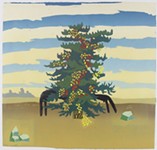'Susan Collis: I would like to invite the viewer'
London-based Susan Collis presents a new realism in her solo show
Reviewed by Seth Orion Schwaiger, Fri., June 13, 2014
'Susan Collis: I would like to invite the viewer'
Lora Reynolds Gallery, 360 Nueces #50Through July 5
Three drawings hang in the Lora Reynolds Gallery project space. Each looks like the product of 10 seconds' work with a large brush and watery ink, a few swipes on large sheets of paper. These surround an "invitation" of sorts: a used office chair next to a set of headphones and head-mounted display. The gyroscopic HMD responds to the wearer's movements while showing brief clips of the artist's studio building. At first, one's mental map of the pristine gallery competes with the visual information of industrial space. The floor gives way to stairs, the ceiling rises, and the light shifts to the pale gray-blue of London. One clip has the artist herself sitting at her desk, back to the viewer, crafting the very works now on display. The clips of stairwells and halls give the impression that these are still images, so the slight movements of the artist are startling. The element of time becomes a factor, and in this way, it's not possible to take in the entire work. Any changes taking place out of sight are simply missed, lost to the past in a way closer to reality than traditional video. This sense is replicated in the next clip, this time in a warehouse elevator complete with rusting, paint-splattered walls and discarded trash bag. The sound and visuals of the floors passing becomes hypnotic. Each of these images would be banal in and of itself, but the immersive transportation the technology allows makes every texture and detail valuable – glamorous even.
After a ride on the magical goggles, the viewer's perceptive faculties are changed, and in this lingering altered state one might notice that something isn't quite right about the drawings. Collis seemed to be taking her sweet time with them in the video – and was that a pencil in her hand? Just as the HMD creates a double presence of conflicting space, the works reveal they too are doppelgängers, now clearly made through hours of painstaking pencil work rather than brush strokes. One finds oneself holding the same image in high regard that moments before one had discounted.
It's this palpable sense of discovery that makes Collis' "I would like to invite the viewer" so powerful. The soft and quiet imagery of the HMD subtly decreases the speed at which the viewer takes in the world. The drawings reinforce that perspective through an immediate pay-off. Leaving the gallery, one can't help but feel changed; like the parallel reality of the pristine gallery/industrial studio or the abstract/perfect realism drawings, the viewer leaves in the same shape he entered but with new, hidden qualities and a nuanced sense of value.













